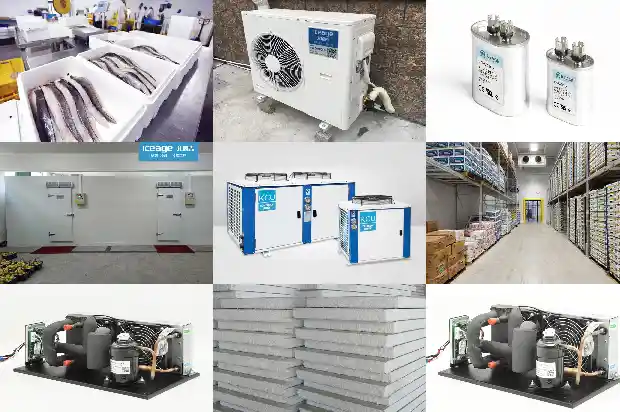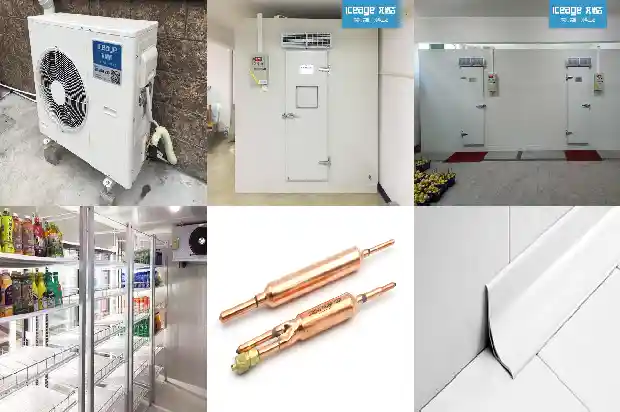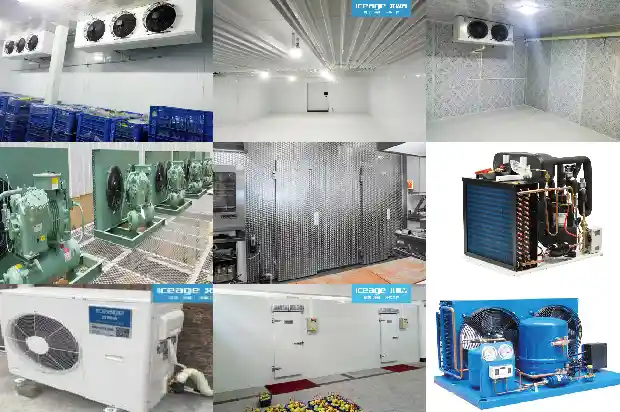Introduction to Six Kinds of Two-stage Compression Refrigeration Systems
2024-12-02
Single-stage compression, two-stage compression, single-stage throttling, double-stage throttling, intermediate complete cooling, intermediate incomplete cooling, vapor injection enthalpy increase, economizer, flash tank;
However, for colleagues who are just starting out in the refrigeration industry, the two-stage compression system is much more complicated than the single-stage compression system. They may not even be clear about some terms and concepts. Today, we will simply distinguish these systems for you.
However, for colleagues who are just starting out in the refrigeration industry, the two-stage compression system is much more complicated than the single-stage compression system. They may not even be clear about some terms and concepts. Today, we will simply distinguish these systems for you.
I. Classification
The two-stage compression refrigeration cycle can be divided into intermediate complete cooling cycle and intermediate incomplete cooling cycle according to the intermediate cooling method.
The intermediate cooling method of the two-stage compression refrigeration cycle is related to the type of refrigerant. For example, in ammonia two-stage refrigeration compressors, the intermediate complete cooling cycle is generally adopted; while in Freon two-stage refrigeration compressors, the intermediate incomplete cooling cycle is mostly used. This is because the adiabatic index of Freon refrigerant is smaller than that of ammonia and has little impact on the exhaust temperature.
The two-stage compression refrigeration cycle can also be divided into single-stage throttling cycle and double-stage throttling cycle according to the throttling method. The so-called intermediate complete cooling means cooling the exhaust gas of the low-pressure stage to saturated vapor under the intermediate pressure.
If the exhaust gas of the low-pressure stage has been cooled but has not been cooled to the saturated vapor state, it is called intermediate incomplete cooling. If the high-pressure liquid is first throttled from the condensing pressure Pk to the intermediate pressure Pm and then throttled from Pm to reduce the pressure to the evaporating pressure Po, it is called a double-stage throttling cycle. If the refrigerant liquid is directly throttled from the condensing pressure Pk to the evaporating pressure Po, it is called a single-stage throttling cycle.
Among air source heat pumps, the most common is the vapor injection enthalpy increase system, which can operate normally at low temperatures and has very little capacity attenuation. There are economizer systems and flash tank systems in the vapor injection enthalpy increase system.
The intermediate cooling method of the two-stage compression refrigeration cycle is related to the type of refrigerant. For example, in ammonia two-stage refrigeration compressors, the intermediate complete cooling cycle is generally adopted; while in Freon two-stage refrigeration compressors, the intermediate incomplete cooling cycle is mostly used. This is because the adiabatic index of Freon refrigerant is smaller than that of ammonia and has little impact on the exhaust temperature.
The two-stage compression refrigeration cycle can also be divided into single-stage throttling cycle and double-stage throttling cycle according to the throttling method. The so-called intermediate complete cooling means cooling the exhaust gas of the low-pressure stage to saturated vapor under the intermediate pressure.
If the exhaust gas of the low-pressure stage has been cooled but has not been cooled to the saturated vapor state, it is called intermediate incomplete cooling. If the high-pressure liquid is first throttled from the condensing pressure Pk to the intermediate pressure Pm and then throttled from Pm to reduce the pressure to the evaporating pressure Po, it is called a double-stage throttling cycle. If the refrigerant liquid is directly throttled from the condensing pressure Pk to the evaporating pressure Po, it is called a single-stage throttling cycle.
Among air source heat pumps, the most common is the vapor injection enthalpy increase system, which can operate normally at low temperatures and has very little capacity attenuation. There are economizer systems and flash tank systems in the vapor injection enthalpy increase system.
II. Single-stage Throttling
- Two-stage compression refrigeration cycle with single-stage throttling and intermediate complete cooling
Working Process:
The low-pressure and low-temperature refrigerant vapor generated in the evaporator is sucked into and compressed by the low-pressure compressor into superheated vapor at the intermediate pressure, and then enters the intercooler at the same pressure and is cooled into dry saturated vapor in the intercooler.
The medium-pressure dry saturated vapor is then sucked into and compressed by the high-pressure compressor into superheated vapor at the condensing pressure, and then enters the condenser to be condensed into refrigerant liquid. Then it is divided into two paths. One path enters the intercooler after being throttled and depressurized by the expansion valve F. Most of the liquid enters the coil in the intercooler from the other path for subcooling.
However, due to the existence of the heat transfer temperature difference, it cannot be cooled to the intermediate temperature in the coil but is generally higher than the intermediate temperature by △t = 3 - 5℃. The subcooled liquid is then throttled and depressurized by the main expansion valve into a low-temperature and low-pressure subcooled liquid and finally enters the evaporator to absorb heat and evaporate, generating a cooling effect. - Two-stage compression refrigeration cycle with single-stage throttling and intermediate incomplete cooling.
Working Process:
The vapor coming out of the evaporator is sucked into the low-pressure compressor after passing through the regenerator, compressed to the intermediate pressure and mixed with the dry saturated vapor coming out of the intercooler in the pipeline, so that the superheated vapor discharged from the low-pressure compressor is cooled before entering the high-pressure compressor, compressed to the condensing pressure and enters the condenser.
The high-pressure refrigerant liquid after condensation enters the serpentine coil of the intercooler for re-cooling, and then enters the regenerator to exchange heat with the low-temperature and low-pressure vapor coming out of the evaporator, so that the subcooled liquid coming out of the serpentine coil of the intercooler is cooled again and finally enters the evaporator through the expansion valve to absorb heat and evaporate.
III. Double-stage Throttling
- Two-stage compression refrigeration cycle with double-stage throttling and intermediate complete cooling.

The saturated refrigerant vapor from the evaporator is sucked into the low-pressure stage compressor, compressed to the intermediate pressure pm and discharged into the intercooler, where it is cooled into saturated vapor by the refrigerant liquid in it. Meanwhile, a part of the liquid refrigerant in the intercooler absorbs heat and becomes saturated vapor. The two together enter the high-pressure stage of the compressor and are compressed again to the condensing pressure pk. They enter the condenser and are condensed into saturated liquid, which is depressurized to the intermediate pressure pm through the throttle valve A and enters the intercooler and is separated into vapor and liquid parts. In the intercooler, a small part of the liquid refrigerant is used to cool the exhaust gas of the low-pressure stage into vapor and is sucked back by the high-pressure stage together with the low-pressure exhaust gas and the vapor generated by throttling. Most of the liquid refrigerant is throttled by the throttle valve B to the evaporating pressure p0 and enters the evaporator to produce cooling capacity, and the cycle repeats continuously.
Note: In order to prevent the saturated liquid coming out of the intercooler from flashing into vapor in the pipeline, it is usually required that the distance between the intercooler and the evaporator should be short. - Two-stage compression refrigeration cycle with double-stage throttling and intermediate incomplete cooling.
The saturated refrigerant vapor from the evaporator is sucked into the low-pressure stage compressor, compressed to the intermediate pressure and mixed with the dry saturated vapor coming out of the intercooler in the pipeline. The two together enter the high-pressure stage of the compressor and are compressed again to the condensing pressure pk. They enter the condenser and are condensed into saturated liquid, which is depressurized to the intermediate pressure pm through the throttle valve A and enters the intercooler and is separated into vapor and liquid parts. In the intercooler, a small part of the liquid refrigerant is used to cool the exhaust gas of the low-pressure stage into vapor and is sucked back by the high-pressure stage together with the low-pressure exhaust gas and the vapor generated by throttling. Most of the liquid refrigerant is throttled by the throttle valve B to the evaporating pressure p0 and enters the evaporator to produce cooling capacity, and the cycle repeats continuously.
IV. Vapor Injection Enthalpy Increase Economizer and Flash Tank
- Economizer System:
Compared with the traditional single-stage vapor compression refrigeration cycle, the vapor injection enthalpy increase system mainly includes: vapor injection enthalpy increase compressor, economizer (flash tank); the rest of the components are the same as those of the ordinary refrigeration system.
Vapor injection reduces the exhaust temperature, at the same time reduces the exhaust superheat degree, reduces the length of the gas-phase heat exchange area of the condenser, increases the two-phase heat exchange area and improves the heat exchange efficiency of the condenser. The greater the difference between the evaporation temperature and the condensation temperature, the better the effect will be, so the effect is more obvious in a low-temperature environment.

Compressor exhaust - four-way valve - condenser - (throttle structure) economizer - throttle structure (compressor injection port) - evaporator - compressor suction port - Flash Tank System:
The high-pressure refrigerant liquid coming out of the condenser is divided into two paths: the refrigeration circuit and the make-up gas circuit.
Related Articles
- Introduction to Inspection and Handling Methods for Refrigerant Leak in Cold Storage
- Introduction to Control Valves in Refrigeration Systems
- Introduction to Basic Types of Cold Storage
- Introduction to Lithium Bromide Absorption Chillers
- Introduction to the Advantages of Dual - temperature Cold Storage
- Introduction to Various Water Tanks in Air - conditioning Systems
- Introduction to the Cleaning Processes and Methods of Heat Exchangers and Cooling Towers
- Introduction to Key Points of Compressor Grouping in Quick-freezing Cold Storage
- Introduction to the Construction and Features of Cold Storage in Cold Chain Logistics
- All-round Introduction to Condensers and Evaporators!
- Introduction to Vapor Barrier of Cold Storage and Moisture Protection of Equipment
- Introduction to Oil Collector in Refrigeration System
- Technical Introduction of Process Cooling Water System
- Introduction to Air-cooled Chiller
- Introduction to Five Classification Functions of Cold Storage Installation for Refrigeration
- Introduction to Precooling Methods for Fruits and Vegetables
- Introduction to the Relationship between Refrigerants and Cold Storage Temperatures
- Introduction to Types of Condensers in Cold Storage
